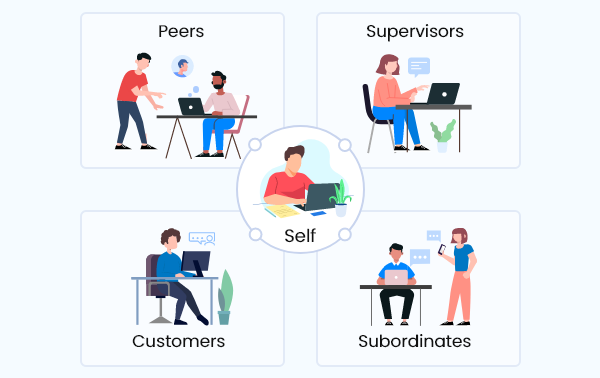Job evaluation methods
Employee feedback is only effective when designed to meet your organization’s unique needs, making performance management an enriching and constructive process. This is why AssessTEAM supports every job evaluation method.
Employee feedback is only effective when designed to meet your organization’s unique needs, making performance management an enriching and constructive process. This is why AssessTEAM supports every job evaluation method.

With AssessTEAM, your evaluations can be structured to meet your organization’s needs, whether highly hierarchical or unstructured and casual. Regardless of your requirements, feedback with AssessTEAM is easy to read and understand. The choice is yours – your HR team can retain complete control of evaluations or they can be delegated to team managers and individual employees.
This is also the most popular and oldest method of performance evaluation. From the supervisors from the Egyptian pyramids 4500 years ago to present-day companies, most companies continue to use this simple method of supervisory evaluation of direct reports. This is where most companies start, and its an excellent first step toward formal performance management.

The goal of 360-degree feedback is to provide a more balanced view of how your employees perceive the contribution and performance of others within your organization. It gives you, the employer, a unique and more accurate perspective for each employee by collecting insight from different levels of association: Downward, Peer, Upward, and Self-evaluations. Areas measured can range from job competencies, core values, behavioral skills, management, teamwork, leadership, work habits, vision, and overall organization mission.

With AssessTEAM, job goals are accurately set up for each person within your organization, clearly laying out expectations at the onset. This allows both supervisors and employees to understand deliverables accurately. It also allows for more accurate collaborative information to be collected and documented for future review. Evaluations are given on demand so that you can document an event when it occurs and save the date for future recollection. Both real-time and scheduled feedback requests can be sent automatically weekly, monthly, quarterly, or annually.

Quality checks are essential for pretty much every industry type. Evaluation of deliverables via a checklist and keeping track of trends are critical to maintaining high standards of quality. There are multiple ways of evaluating quality; this can be generalized free text quality input, evaluated via compliance parameters, or averaged out of multiple statistical inputs.

This is among the most important evaluation methods that deliver input to new hires at scheduled intervals to ensure they have the right information to understand job expectations and deliver the results the job requires.

It also motivates and reminds each employee that you remember when they joined your team. A large number of companies opt for this method of evaluation to ensure there is no specific time period when the entire team would need to be evaluated, This method helps managers focus on staff individually and deliver input that’s specific and not comparative to other members of the team.

This process captures historical data that can be utilized for real-time analysis and reporting. The advantages of evaluating the complete team together ensure there is symmetry in the process of evaluation of every team member, and the process can be scheduled appropriately with finite start and finish timelines-delivery of detailed team-wise performance reporting to be used for making data-driven decisions.

Manager 1:1s are even more important for new hires who may need consistent guidance to understand job responsibilities. This type of evaluation is common in larger companies where the team size demands each individual should get face time with their manager to clarify questions and provide an update on ongoing consistently.

This evaluation type is applicable to pretty much every size team. Getting the complete team in a single location or a web conference to discuss matters that affect performance, delivery, and customer confidence is key to keeping organizational goals in focus. Metrics discussed in these meetings are collated for future analysis and comparisons.

Engagement surveys also help you gather business intelligence to make decisions regarding training, promotions and policy formation. Pulse surveys often bring up suggestions that the team could not discuss with their reporting managers or the HR.

This is the most important evaluation for service-oriented companies. Learning how the customer feels about delivered services is critical to the success of most companies. This data can be measured accurately and analyzed over time to see how specific changes in policies affect customer satisfaction.

This simple method is popular with many manufacturing and service-oriented companies. More and more companies are adopting this modern evaluation technique due to the simplicity of the process. Managers look for good and bad behaviors and make a note of it, its as simple as that!

Mobile apps not only make performance evaluations convenient they also add a measure of fun to the entire process. Most professionals are already used to doing everything on phone apps, and performance management via an app is quickly accepted. Both managers and employees love the flexibility, ease of use, and quick feedback possibilities.

This is a time-tested method of evaluation that can bring frank input from the entire team. This can be a simple organizational review, 360-degree feedback or a pulse survey that gets you anonymous feedback. Companies often conduct anonymous evaluations by teams to evaluate team dynamics and consider the findings in their decision-making process.

This is a common methodology, as responsibilities assigned to employees seldom have the same priority. Assigning clear priorities helps employees focus on the things that matter most. Weights can be assigned to KPIs, Goals, and general responsibilities.

It is important in a stressful work environment where employees would appreciate an informal mode of feedback. This is often useful when you have a young term that’s tech-savvy. Emoticons have become the language of choice for millennials. Emoticons are informal, but they can deliver a clear message to your team in a simple non, threatening way that encourages better communication.
This is very popular with tech companies that encourage endorsements within teams to recognize accomplishments in projects, communication, and technologies. Professionals from all walks of life appreciate being recognized by their peers.

This is popular for companies that have multiple team leaders and project managers. Review requests help gather reviews from several evaluators without time-consuming independent evaluations. Review requests are popular as a collaborative tool to ensure a holistic evaluation process.

This is often used where employee performance is directly related to a finite deliverable. All companies measure targets, and evaluations of measurable goals is the most common type of evaluation. The key is to ensure employees know the targets to be achieved, measure them accurately, and compute trends for comparative analysis.

It is an essential organizational tool that is helping your team track targets, certifications, or competency milestones. Goals may be set by the employees, their managers, or by the HR team with evaluations periodically, at will, or at completion based on your individual needs. AssessTEAM goal-setting options are easily configured at individual and team levels. Access can be given to specific job titles to set up goals for themselves and their teams. The person of your choosing evaluates goals within the company. All team members see the goals within their result areas, and clarity is maintained on progress in achieving those goals.

Job evaluation methods enable employers to build a robust workforce by assessing how their employees contribute to the organization. Well-designed job evaluations are highly effective tools that help employees and employers identify areas of strength and weakness, strengthening the organization.
Regardless of your organizational size or industry, employee job evaluation methods are critical to managing your business. Opportunities derived from performance management software often lead to massive improvements in team efficiency. Knowing who your top performers are and what products your team executes most effectively can lead to wiser decision-making. Employees using AssessTEAM understand their jobs better, receive clear, timely input, and understand which path will lead them toward improved job performance.
AssessTEAM supports every way an organization chooses to run employee evaluations. If you need a job evaluation method that is not listed on this page, email us, and we will make it happen!